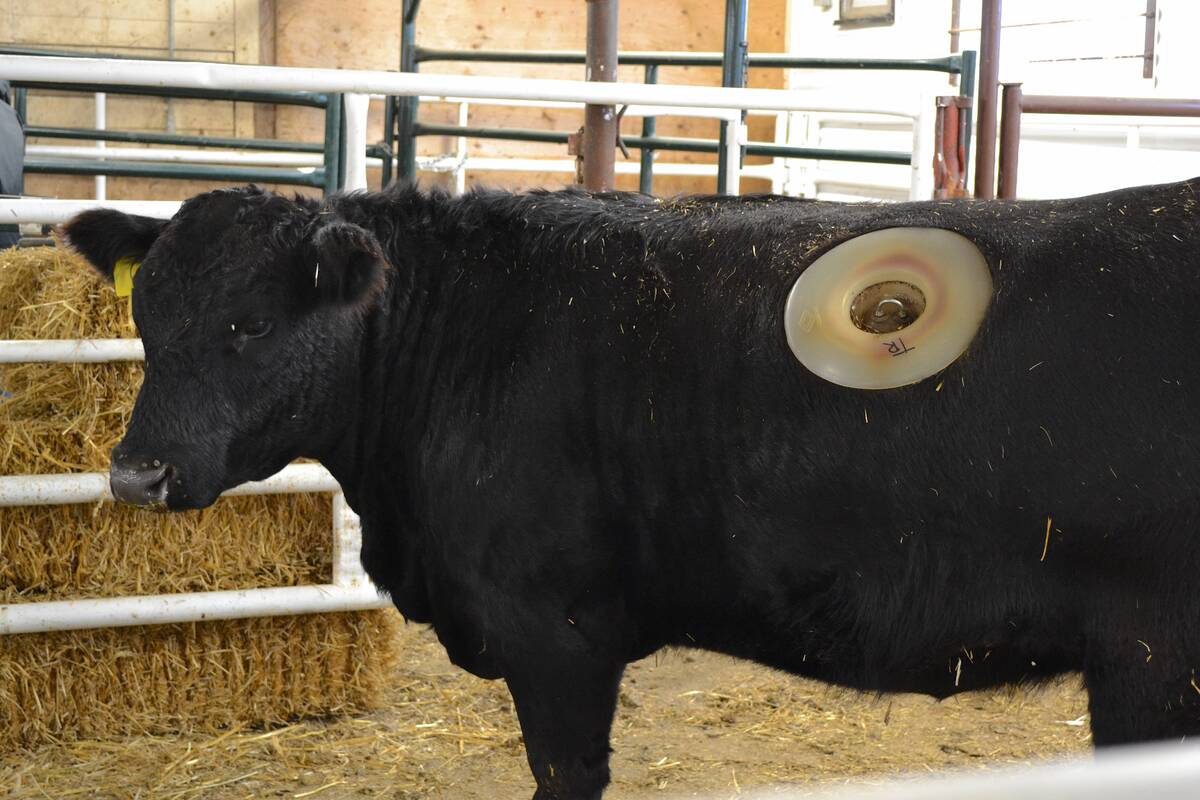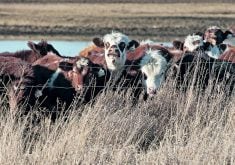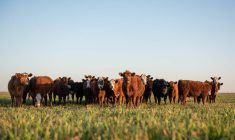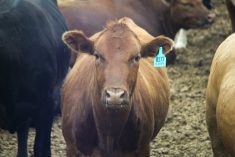The Eastern Slopes are what many people picture when they think of Alberta — a sweeping landscape of grass and rolling hills giving way to forests and ridges framed by the majesty of the Rocky Mountains.
But all that beauty masks serious issues, including the considerable strain on riparian areas.
Key to the effort to keep things flowing and protect water in southern Alberta are conservationists and producers, including ranchers Kelly and Glen Hall.
Read Also

Lakeland College studying livestock wellness through cannulated heifers
Lakeland College’s Applied Research Team is working with six cannulated heifers on a handful of research projects.
“When we look after the water and the soil, we’re looking after someone else’s drinking water, and that’s critical,” Glen said.
“You can turn on a tap and water comes out, but that’s not the whole story,” Kelly added. “The rest of this story is really important, and understanding that our soil and our water are the most critical assets of this entire country is something that everybody needs to get better at.”
The couple has spent decades learning to manage riparian areas, the strips of land along creeks, rivers, lakes and wetlands.
Riparian areas cover just two per cent of the province but play a major role in watersheds. They act like sponges to regulate flow and protect the surrounding land from drought and flood damage, said Kelsey Spicer-Rawe of the Alberta Riparian Habitat Management Society, the non-profit better known as Cows and Fish.
“They do a lot of important functions, like trapping and storing sediment and they help to recharge aquifers and they help to clean water,” said Spicer-Rawe, a riparian specialist. “They’re pretty critical pieces of the land.”

The Halls farm 2,200 acres and have a 150-head cow-calf operation in the Oldman watershed. It is a 27,000-square-kilometre region in the province’s southwest corner that is home to several rivers that provide water to 200,000 people and several irrigation districts.
But more than half of the watershed’s riparian areas are stressed, according to a 2018 report from a coalition of conservation groups advocating for a conservation strategy for the Eastern Slopes. Across Alberta, less than 29 per cent of riparian areas were completely healthy in a 2018 analysis, reports Cows and Fish.
The Halls didn’t need a report to tell them there were problems when they bought land in the Porcupine Hills and saw the deterioration of the banks of Mosquito Creek, which runs through pasture land they were managing 25 miles east.
The stark contrast in water quality from the headwaters to the creek where they drew water for irrigation was the call for improvement, the couple said.
“It was pretty dry, tough years back then,” Glen said. “When we first purchased the ranch in ’85, right then we knew that water was the most important thing.”
“We became very focused on protecting that water – using what we need but leaving it as healthy as we could as it flowed down the stream, which affected, of course, everybody in the Oldman watershed but it affected ourselves as well,” Kelly said.
The snow that falls on that portion of the Eastern Slopes supplies 70 to 90 per cent of water in the Oldman River Basin, but as the climate warms, the snow melts earlier and evaporation increases. As water volumes decrease, silt and pollutants concentrate, lowering the quality and quantity of water flowing west.
Riparian areas can help buffer these effects, cleaning and storing water and improving the land’s ability to retain it. But only if they’re healthy enough to function.
Repairing them takes time, but the Halls said the steps aren’t hard.
“We base a lot of things on the KISS principle – Keep It Simple Stupid,” said Kelly. “And the No. 1 principle for us is we never water directly from the source.”
To keep their herd off stream banks and out of natural springs, the Halls use electric fencing, gravity flow pipes and solar-powered off-site watering systems.
Portable fencing and watering systems allow them to implement rules No. 2 and No. 3: Graze fast and hard, but always leave cover.

Prolonged rest lets plants grow deep roots (that increases hardiness) and vegetation (that shields the soil from the sun, wind and heavy rain, all of which can cause erosion).
“Our fourth principle is appreciate diversity,” Kelly said. “That root system of a diverse landscape is critical to holding water.”
Electric fencing doesn’t cost a lot, said Glen, and although watering systems are more of an investment, they pay off. Keeping cows out of springs and streams benefits the Hall’s land and keeps their cattle healthy, too.
“There are those economic benefits of providing clean water for livestock. It ends up with improved herd health, but also improvements to weight gain,” said Spicer-Rawe.
For producers wondering where to start, there are groups to help, Kelly said.
“We have found a way to find a tremendous amount of allies that have helped us use the best management practices possible,” she said. “You can bring experts of a variety of fields together. Everybody wins.
“Expertise around the table that is shared becomes bigger, broader, and more user friendly.”
Among the groups offering funding or programs are Cows and Fish, the Alberta Conservation Association, ALUS, groups administering Ottawa’s On-Farm Climate Action Fund (for a list, click on the link on the homepage), the Foothills Forage and Grazing Association and other farmer-directed research organizations in the province.
The Halls have worked with many of them, most notably the Alberta Conservation Association, with which they have a co-tenancy and management agreement on their Timber Ridge ranch.
“We do our very best to be humble but we know that we have come through the last five years in a better place because of the management changes that we’ve made over the last 30 years with the help of ACA, Cows and Fish, the Oldman Watershed Council (and) Foothills Forage,” Kelly said.
The property is partly protected under a conservation easement and the Halls host workshops on the ranch for conservation organizations.
“Because of putting those KISS principles in place, we have systems we can show people,” she said. “And they turn around and share it with somebody else and that’s what we have to continue to do, is build the respect for the land and for what the land is capable of providing for all of us.”
A while ago, the Halls had some other special visitors. Beavers moved into a catch basin, a sign that their work on riparian areas was meeting with approval from Mother Nature’s water engineers. The drought of 2021 forced them out, but the couple are hoping for their return.
“It was a little sign,” said Kelly. “We hadn’t seen beavers for about 20 years, but they returned and that’s a good thing.”















